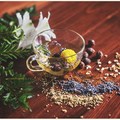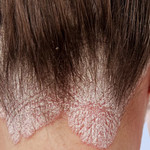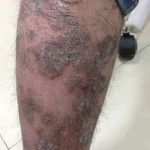About Psoriasis (PDF Download at end)
白疕 Bái Bǐ (“white crust”)
Psoriasis, a complicated autoimmune condition, primarily targets the skin and occasionally the joints, affecting about 4% of the U.S. population. This lifelong disease features periods of exacerbation and remission, often resulting in significant emotional and physical distress.
The exact cause of psoriasis remains unclear, though it is known to be hereditary and is more likely to occur if both parents are affected. Psoriasis typically manifests between puberty and age 30 (Type I), with environmental factors playing a crucial role in its onset and progression. Often, the initial episode is triggered by a strep throat infection, while stress can easily provoke subsequent flare-ups. There is also a second incidence peak in the 50s and 60s (Type II), which tends to be less severe.
Common plaque psoriasis begins with a single papule (small, solid, raised lesion) that evolves into well-defined, symmetrical raised red plaques with varying degrees of scaling. This thickening and scaling result from the over-proliferation of skin cells, causing too many to be produced too quickly, causing a pile up of extra skin (the “scales”).
The impact of this disease on a patient's self-esteem can lead to social withdrawal and isolation, making it a truly devastating condition. While there is currently no cure for psoriasis, treatment aims to achieve remission, providing relief from its symptoms.
Chinese herbal dermatology is an effective, safe option for many people with common plaque psoriasis. Because of Dermatology’s specificity in both theory and herb choices, it is highly recommended to seek out a Doctor of Chinese Medicine trained specifically in Dermatology.
Variants of Common Plaque Psoriasis
- Scalp Psoriasis. Characterized by thick scaling and well-demarcated plaques on the scalp, sometimes extending to the forehead (corona psoriatica), and generally does not cause permanent hair loss.
- Palmar-Plantar Psoriasis (Hands & Feet). This form features well-demarcated erythema (“redness”), and thin scaling on the palms and soles, possibly extending to fingers/toes and the dorsum, often mistaken for eczema, but lacking vesicles.
- Palmar-Plantar Pustular Psoriasis. This condition causes deep yellow pustules on palms and soles, which turn brown and shed. The surrounding skin is red, shiny, and scaly, causing pain and affecting walking, typically without itching. It's more common on the feet, often linked to smoking, and can persist for years.
- Inverse Psoriasis. Involves red (color can vary depending on skin tone), well-demarcated lesions in skin-on-skin areas like the armpits, groin, under breasts, and behind ears, with decreased scaling due to friction and common fissuring.
- Nail Psoriasis. Affects 25-50% of psoriasis patients and 80% of those with psoriatic arthritis, causing onycholysis (separation of the nail from the nail bed), pitting, "oil spot" lesions, and nail dystrophy (structural abnormalities).
PATIENT INFORAMTION - PLAQUE PSORIASIS
Psoriasis is a persistent inflammatory skin condition affecting up to 4% of the U.S. population. While it currently has no cure, remission is possible, and it is recognized as an autoimmune disease, though it is not contagious. Chinese herbal therapy, is an effective treatment for common plaque psoriasis, with remission and maintenance of remission the goal.
- Psoriasis manifests in several forms, with common plaque psoriasis accounting for 90% of cases.
- The majority of psoriasis cases emerge between puberty and age 30 (Type I) and have a hereditary component, especially if both parents are affected. There is a second incidence peak in the 50s and 60s (Type II), typically less severe.
- Common plaque psoriasis starts with a red bump (papule) that evolves into well-defined, symmetrical raised red (can vary depending on skin tone) plaques with varying degrees of scaling.
- Lesions can appear anywhere but are most commonly found on the elbows, knees, scalp, lower back, and sacrum.
- Nail involvement occurs in up to 50% of psoriasis patients, and around 30% experience joint pain (psoriatic arthritis), usually accompanied by skin lesions.
- In healthy skin, epithelial cells take 28 days to reach the surface, but in psoriasis, they do so in just 4 days, leading to the accumulation of cells and the formation of silvery scales.
- Psoriasis scales can be easily removed by scratching, revealing a moist layer underneath. Continued scratching can cause pinpoint bleeding (Auspitz’s sign).
- Lesions can spread due to skin trauma such as sunburn, infections, allergic reactions, or injuries like cuts and scrapes, so protecting the skin is crucial to prevent spreading.
- In children and teenagers, upper respiratory infections, particularly those causing a sore throat, can trigger guttate psoriasis, which may develop into chronic plaque psoriasis. Stress has been found connected to a first outbreak, or flare-ups in adults.
PSORIASIS DO’S AND DON’TS
Psoriasis Do’s
- Do talk to a dermatologist. Consult a conventional dermatologist or doctor of Chinese Medicine with a specialty in dermatology, to discuss your symptoms, triggers, and past treatments to create an effective management plan.
- Do moisturize. Keep your skin hydrated, especially after bathing and during winter months, to prevent dryness and scaling, or triggering an outbreak during remission.
- Do take a soak. Soaking in a warm bath with added sea salt, oatmeal, bath oil, or coal tar can help loosen scales and reduce itching and inflammation.
- Do get some sun. Controlled sun exposure can help reduce psoriasis lesions, but protect unaffected skin with sunscreen and limit exposure to avoid sunburn.
- Do reach out. Discuss your feelings with family, friends, or support groups to cope with the emotional challenges of psoriasis and remember you're not alone.
Psoriasis Don’ts
- Don’t overdo it. Avoid scratching or scrubbing lesions, picking at scales, and using hot water or abrasive cleaners, which can worsen your symptoms.
- Don’t stress out. Manage stress through techniques like meditation, relaxation, and exercise, as stress can exacerbate psoriasis.
- Don’t ignore flare-ups. If your psoriasis flares up after a period of control, contact your treating provider to adjust your treatment plan accordingly.
- Don’t give up. Be patient and consistent with your treatment plan, as finding the right therapy can take time and persistence is key.
- Don’t consume these. Dietary recommendations include avoiding alcohol, stopping smoking, avoiding shellfish (such as shrimp, crab, lobster, mussels, oysters), limiting meat intake (especially chicken), reducing fatty foods, and avoiding spicy foods (like chili, curry, hot peppers, garlic, and onion).

Kim Drolet
Contact Me









